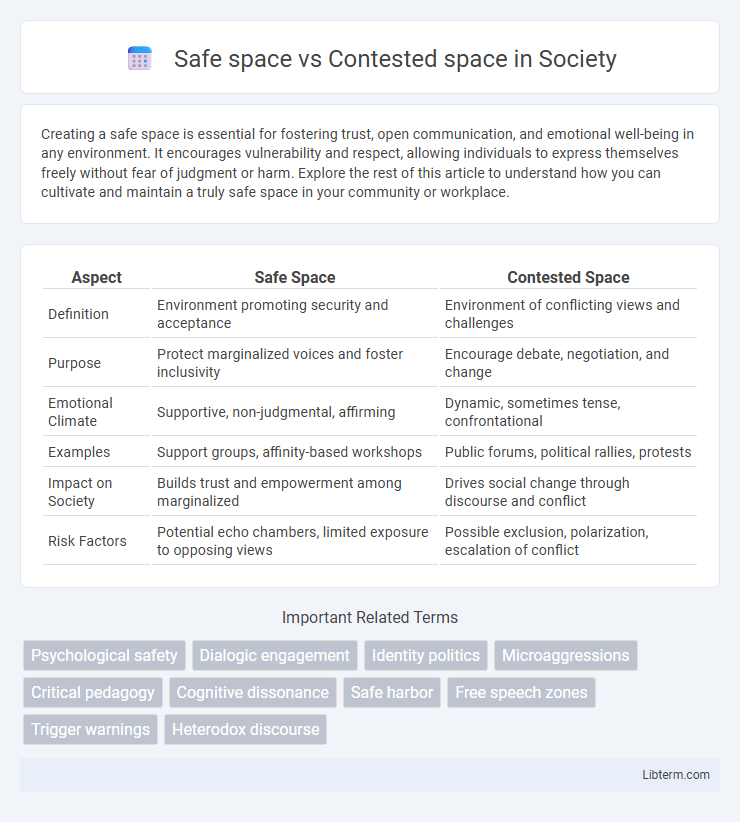Creating a safe space is essential for fostering trust, open communication, and emotional well-being in any environment. It encourages vulnerability and respect, allowing individuals to express themselves freely without fear of judgment or harm. Explore the rest of this article to understand how you can cultivate and maintain a truly safe space in your community or workplace.
Table of Comparison
| Aspect | Safe Space | Contested Space |
|---|---|---|
| Definition | Environment promoting security and acceptance | Environment of conflicting views and challenges |
| Purpose | Protect marginalized voices and foster inclusivity | Encourage debate, negotiation, and change |
| Emotional Climate | Supportive, non-judgmental, affirming | Dynamic, sometimes tense, confrontational |
| Examples | Support groups, affinity-based workshops | Public forums, political rallies, protests |
| Impact on Society | Builds trust and empowerment among marginalized | Drives social change through discourse and conflict |
| Risk Factors | Potential echo chambers, limited exposure to opposing views | Possible exclusion, polarization, escalation of conflict |
Defining Safe Spaces and Contested Spaces
Safe spaces are environments where individuals, especially from marginalized groups, feel protected from discrimination, judgment, or harm, enabling open expression and emotional safety. Contested spaces refer to areas--physical, social, or ideological--marked by conflicting interests, power struggles, or competing claims over meaning, identity, or access. Understanding the distinctions hinges on recognizing safe spaces prioritize inclusivity and protection, while contested spaces embody ongoing negotiation and conflict over resources or values.
Historical Origins of Safe and Contested Spaces
Safe spaces emerged historically as protected environments designed to offer marginalized groups refuge from discrimination, often rooted in civil rights and social justice movements of the 1960s and 1970s. Contested spaces have origins in political, social, or cultural conflicts where control and meaning are actively disputed, often shaped by colonialism, territorial disputes, and urban development struggles. The historical origins of these spaces reflect broader power dynamics, with safe spaces providing sanctuary and contested spaces embodying struggle and negotiation over identity and resources.
Key Characteristics of Safe Spaces
Safe spaces prioritize emotional security, inclusivity, and respect, providing environments where individuals can express themselves without fear of judgment or discrimination. These spaces enforce clear boundaries, support open dialogue, and often implement policies to prevent harassment and promote mutual understanding. Safe spaces foster trust and encourage participation, emphasizing the protection of marginalized groups and the validation of diverse perspectives.
Key Characteristics of Contested Spaces
Contested spaces are characterized by conflicting claims, social tensions, and power struggles between different groups or individuals competing for control, access, or identity. These spaces often reflect a dynamic interplay of cultural, political, or economic disputes, where boundaries and meanings are constantly negotiated and challenged. Unlike safe spaces, contested spaces lack a consensus on norms, creating an environment marked by uncertainty, resistance, and frequent confrontation.
The Role of Identity in Space Formation
Identity plays a crucial role in the formation of safe spaces and contested spaces by shaping how individuals and groups perceive inclusion and exclusion. Safe spaces are often created when shared identities foster trust and mutual understanding, enabling marginalized communities to express themselves without fear of judgment or harm. Conversely, contested spaces emerge when conflicting identities challenge social norms and power structures, resulting in tensions over belonging and access.
Advantages and Limitations of Safe Spaces
Safe spaces provide environments where individuals can express themselves without fear of judgment or harm, fostering emotional well-being and open communication. They encourage trust and support among participants, promoting mental health and inclusive dialogue. However, safe spaces may limit exposure to diverse perspectives and critical debates, potentially creating echo chambers that hinder growth and resilience.
The Dynamics of Dialogue in Contested Spaces
Contested spaces often feature power imbalances and diverse, conflicting perspectives that shape the dynamics of dialogue, fostering both tension and potential for transformative conversations. Dialogue in these environments requires active listening, empathy, and conflict resolution skills to navigate misunderstandings and build mutual respect among participants. The fluid nature of contested spaces highlights the importance of adaptive communication strategies to maintain engagement and promote constructive exchanges.
Safe Spaces vs. Contested Spaces in Educational Settings
Safe spaces in educational settings provide environments where students feel secure to express their identities and opinions without fear of judgment or discrimination, fostering inclusivity and emotional well-being. Contested spaces, on the other hand, are areas where differing viewpoints clash, often challenging dominant narratives and prompting critical discussions that can lead to social and intellectual growth. Balancing safe and contested spaces is essential for promoting both respectful dialogue and robust learning experiences in schools and universities.
Navigating Conflict: Bridging Safe and Contested Spaces
Navigating conflict requires understanding the dynamics between safe spaces, where individuals feel secure to express ideas without fear, and contested spaces, characterized by competing viewpoints and tension. Strategies to bridge these spaces involve fostering empathy, active listening, and establishing common goals that encourage dialogue while respecting diverse perspectives. Creating frameworks for respectful engagement transforms contested spaces into opportunities for collaborative problem-solving and mutual growth.
Future Perspectives on Inclusive and Critical Spaces
Future perspectives on inclusive and critical spaces emphasize the transformation of safe spaces into dynamic environments that encourage open dialogue while protecting marginalized voices. Contested spaces, recognized for fostering critical engagement and challenging dominant narratives, require adaptive frameworks that balance confrontation with empathy to promote societal progress. Integrating digital technologies and intersectional policies will be crucial in shaping spaces that are both inclusive and critically transformative.
Safe space Infographic

 libterm.com
libterm.com